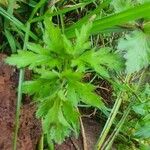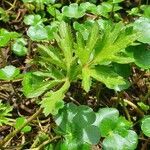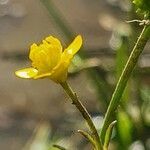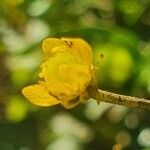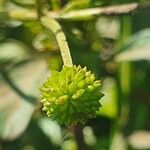Perennial herb most often with erect stems, 1–12 cm. tall, rarely stems more or less prostrate and rooting at some of the nodes, pilose with adpressed hairs pointing upwards; flowering stems much branched in the upper part with numerous relatively small typically “ buttercup ” flowers.. Leaves variable, bi-or tri-pinnatisect, the final segments coarsely and irregularly toothed, strongly to weakly hirsute or pilose.. Sepals reflexed.. Petals 5, yellow, 3–7 mm. long.. Achenes in a spherical to slightly elongated head, persistent beak short to well developed and hooked, margin bordered, sides flat, generally with small scattered tubercles but sometimes smooth.. Fig. 4/1, (p. 17).
Perennial herb, stems erect, 0.05-0.90 m high; indumentum appressed-hairy to hirsute. Leaves in rosettes and cauline; laminas compound, coarsely and irregularly toothed; petioles of basal leaves up to 300 mm long. Stipules sheathing, fused to petiole. Peduncles up to 90 mm long. Flowers leaf-opposed in simple or compound cymes. Sepals ovate, hirsute on outside. Petals 5, obovate, basal nectariferous pits cup-like. Stamens many. Receptacle hairy, elongating in fruit. Flowering time Aug.-Apr. Fruit ± 50 nutlets, obovoid, ± 1.5 mm long, keeled, glabrous, subterminally beaked.
Robust, erect herb, up to 1 m high. Leaves bi-or tripinnate; blade ovate, pubescent; petioles up to 300 mm long; stipules sheath-like, fused and running into petiole. Flowers: in simple or compound cymes; petals 3-10 mm long, yellow; Sep.-Feb. Fruit ± 40-60 in a spherical to slightly elongated head; nutlet laterally flattened, glabrous.
A herb. It keeps growing from year to year. It has swollen tubers. The stems are erect. It grows 1 m high. The leaves are mostly in a ring at the base. The leaves are twice divided and the leaflets have irregular teeth. The flowers are small and bright yellow. They are 2 cm across. They are on long branched, hollow stems.
Tufted, silky perennial, up to 0.9 m tall. Leaves in a basal rosette and along stem, pinnatisect or bipinnatisect, segments toothed. Flowers in simple or compound cymes, yellow. Achenes warty, 1.5-2 mm long.
Perennial herb up to about 1 m. tall, appressed-pubescent with hairs directed upwards to patent-pilose; stems much branched in the upper part with numerous yellow flowers about 12–16 mm. in diam.
Achenes in a spherical to slightly elongated head, numerous, smooth or with small scattered tubercles, with bordered margin and with short or well-developed beak.
Tufted, silky perennial to 90 cm. Leaves pinnatisect or bipinnatisect, segments toothed. Flowers in open panicles, yellow. Achenes warty, 1.5-2.0 mm long.
Robust, erect herb, up to 1 m tall. Basal leaves bi-or tripinnate, pubescent. Achenes 102-152 cm spherical to slightly elongated head. Flowers yellow.
Leaves bi-or tripinnatisect, the final segments coarsely and irregularly toothed, strongly to weakly hirsute or pilose.
Perennial herb most often with erect stems, up to 4 ft. high
Petals 5, yellow, 3–7 mm. long.
Sepals reflexed.
Flowers yellow.
